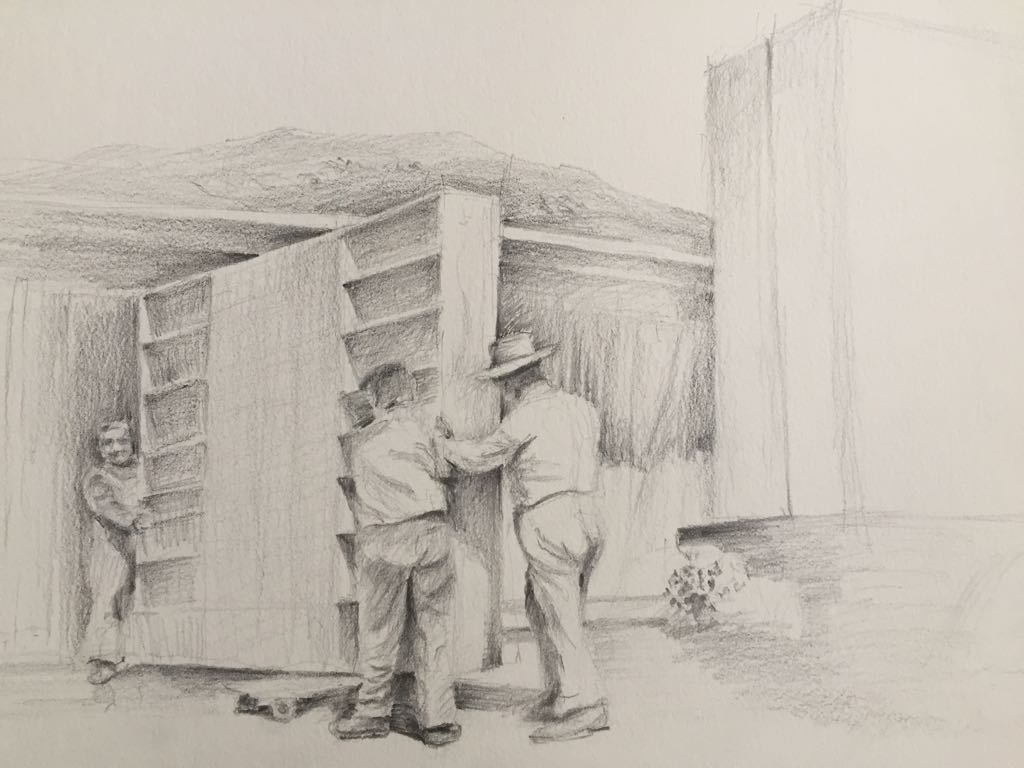In 1935 Le Corbusier visited the Ford production plant at River Rouge and transcribed his impressions: “I came out of the Ford factories at Detroit. As an architect, I am plunged into a kind of stupor. When I take less than a thousand dollars to a building lot I cannot get even a single room built! Here, for the same money, you can buy a Ford car. (…) All of those mechanical marvels are yours for less than a thousand dollars! (…) This is the dramatic conflict which is strangling architecture, which causes ‘building’ to remain off the roads of progress. In the Ford factory, everything is collaboration, unity of views, unity of purpose, a perfect convergence of the totality of gestures and ideas. With us, in building, there is nothing but contradictions, hostilities, dispersion, divergence of views, affirmation of opposed purposes, pawing the ground.”
Walter Gropius wrote the same year: “Standardization is not an impediment of civilization, but, on the contrary one of its immediate prerequisites.” Enthusiasm from the fathers of Modern architecture for the standardized production of consumer goods, where the car (a habitable space) is paradigm, does not leave any doubt: industrial production’s archetype is installed within the collective subconscious of modernity’s aspirations of modernity.
We may track the origins of this trend in the texts of Viollet-le-Duc, one of the most influential precedents of architectural Modernism. As it is possible to deduce from his idealized vision of Gothic cathedrals, for him, the best building was “the one that gets the best with less resources”. The structure of a cathedral uses the stone carrying capacity and its inability to support tractions to shelter as much space as possible and to reach a higher height with the less quantity of material.
Curiously, in a similar line of thought, Henry Ford stated that “for some clumsy reason we have come to confuse strength with weight. The crude methods of early building undoubtedly had something to do with this (…). The mentality of the man who does things in the world is agile, light and strong. The most beautiful things in the world are those from which all excess weight has been eliminated. Strength is never just weight – either in men or things”.
Frank Lloyd Wright was a debtor of Viollet-le-Duc and he wrote about the French author’s treaty “Entretiens sur l’architecture”: “Here you find everything you need to know of architecture”. It is not difficult to find these interrelated visions at the dawn of theoretical bases of modern architecture. We may understand the devotion for prefabrication (and more specifically for light prefabrication applied to housing) if we add the utopia-rooted social consciousness that fills the avant-gardes (and that lies beneath the enthusiastic document from Le Corbusier about River Rouge factory).
Then it does not seem strange to verify a continuous presence of light prefabrication experiments within almost every master’s career through the “heroic” period of modern architecture. Those experiments failed most of the time. Even Wright and Gropius led some of the most well-known fails: “American System Built Houses” and “Packaged Houses”. In “The Dream of the Factory-Made House” Gilbert Herbert describes the paradox: most well-known architects throughout the 20th century tried once and again without any remarkable result but, for some indescribable reason, the fight goes on.
Maybe social responsibility is at the bottom of the never-ending attempts of making up more efficient houses, affordable as cars and (in the current energy crisis period, we may add) with a lesser consume of material resources in their aimed lightness. Those materialized experiences do not show a very fruitful panorama when confronted with the conventional way of producing architecture, but proposals have not decreased in number and depth, being renovated each decade.
Industrialization, as well as in the car industry, has reduced times and organized costs and it is not only in the agenda of those assertive architects. Daily life shows us that in the collective subconscious of housing users a machinist ideals’ good press still lies beneath. This discourse remains new and contemporary, almost a century after, barely eroded by failed experiences of the evidence of how a relevant part of the building process is still rather handcrafted. Everybody wants to be more efficient, more controlled, more technological, more optimist, cleaner, etc. despite specific site conditions, limitations that come from the productive area, custom resistances, cultural inheritances o memory.
That’s the reason why it is easier for a client to identify himself with proposals following the principles of industrialization, that carry promises of freedom from the heavy loads of traditional construction. “Your house ready in a month” is still a type of slogan that carries modernity and optimism values.
Living Kits houses, where we had the opportunity to take part in, were proposed as an attempt bring to reality the same kind of Utopia: it is possible to have a medium size single-family house, built in less than a month, with a prize around 1,000 euros per square meter. We had to make an extra effort to build up an integrated system of normalized pieces, mainly prefabricated, with weight and transport dimension limitations which let a highly efficient sequence of construction.
There are so many proposals about industrialized housing but the only filter is reality. With the first of Living Kits systems, several examples of ready-made houses have been built, like the LK 3 house in Churriana, built up just in one month, as it is shown in the building diary. The process needs extremely precise details and a longer period of preparation before site work. Resolution tension moves from site to computer screens. But users with limited time or those who need the maximum efficiency in costs and processes may find an ancient Utopia coming true: a house in a month.


